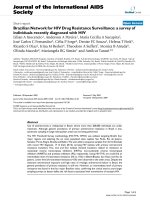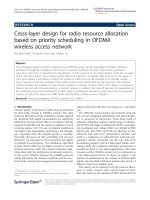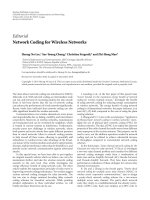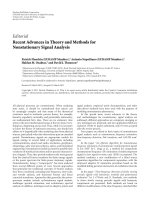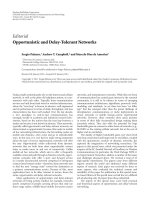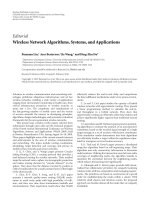Báo cáo hóa học: " Editorial Network Coding for Wireless Networks" pptx
Bạn đang xem bản rút gọn của tài liệu. Xem và tải ngay bản đầy đủ của tài liệu tại đây (429.08 KB, 2 trang )
Hindawi Publishing Corporation
EURASIP Journal on Wireless Communications and Networking
Volume 2010, Article ID 359475, 2 pages
doi:10.1155/2010/359475
Editorial
Network Coding for Wireless Networks
Heung-No Lee,
1
Sae-Young Chung,
2
Christina Fragouli,
3
and Zhi-Hong Mao
4
1
School of Information and Communications, GIST, Gwangju, Republic of Korea
2
School of EECS, KAIST, Daejeon, Republic of Korea
3
School of Computer and Communication Sciences, EPFL, Lausanne, Switzerland
4
ECE Department, The University of Pittsburgh, Pittsburgh, PA, USA
Correspondence should be addressed to Heung-No Lee,
Received 31 December 2010; Accepted 31 December 2010
Copyright © 2010 Heung-No Lee et al. This is an open access article distributed under the Creative Commons Attribution License,
which permits unrestricted use, distribution, and reproduction in any medium, provided the original work is properly cited.
The main idea in network coding was introduced in 2000 by
Ahlswede et al. With network coding, an intermediate node
can not only forward its incoming packets but also encode
them. It has been shown that the use of network coding
can enhance the performance of wired networks significantly.
Recent works have indicated that network coding can also
offer significant benefits for wireless networks.
Communications over wireless channels are error-prone
and unpredictable due to fading, mobility, and intermittent
connectivity. Moreover, in wireless networks, transmissions
are broadcasted and can be overheard by neighbors, which
is treated in current systems as interference. Furthermore,
security poses new challenges in wireless networks, where
both passive and a ctive attacks have quite different premises
than in wired networks. Ideas in network coding promise
to help toward all these issues, allowing to gracefully add
redundancy to combat errors, take advantage of the broad-
cast nature of the wireless medium and achieve opportunistic
diversity, exploit interference rather than be limited by it, and
provide secure network communication against adversarial
attacks.
In this special issue, we have been able to put together
six original research articles which we believe c an carry the
momentum further and take the wireless network coding
research to the next level. One article investigates the
energy efficiency benefit of using network code. The other
article exploits the sup erposition principle of radio waves in
improving network coding performance. Two articles suggest
various network coding strategies for relay networks. The
last two aim to design minimal decoding delay network
coding schemes for broadcast networks. While pointing
detailed explanation to these individual articles, we will
briefly introduce them here one by one.
J. Goseling et al., in the first paper of this special issue
“Lowerboundsonthemaximumenergybenefitofnetwork
coding for wireless multiple unicast,” investigate the benefit
of using network coding for reducing energy consumption
in wireless networks. The energy benefit of using network
coding in d-dimensional networks, the paper indicates, is at
least 2d/
√
d-fold, compared to the case of using the plain
routing solution.
S. Zhang and S. C. Liew in the second paper, “Application
of physical-layer network coding in wireless networks,” inve s -
tigate the use of physical-layer network coding (PNC) for
wireless networks. The idea of PNC is to exploit the inherent
property of the radio channel that radio waves from different
users superpose at the receiver antenna. This property can be
used to carry out the addition operation needed in network
coding and can be utilized to achieve substantial increase
in throughput compared to conventional network coding
schemes.
In the third paper, “Joint channel-network coding for the
Gaussian two-way two-relay network,” P. Hu e t al. investigate
a two-way relay channel problem and consider five differ ent
network coding strategies made from a combination of
basic ones such as Amplify-Forward (AF), Decode-Forward,
and Decode-Amplify Forward. They have done extensive
performance evaluations of these strategies for various relay
channel environments.
B. Du and J. Zhang in the fourth paper, “Parity-check
network coding for multiple access relay c hannel (MARC) in
w i reless sensor cooperative communications,”aimtodesign
a parity-check network coding scheme for a two-source
multiple access relay channel. The parity-check network
code, they imply, is a multidimensional low-density parity-
check (LDPC) code. Each user employs an LDPC code t o
2 EURASIP Journal on Wireless Communications and Networking
encode one’s own source data, and the relay adds extra
parity-check bits. The extra bits can be used as a “binning”
process and make the overall coding scheme to be stronger
in its error correction capability.
X. Wang et al., in the fifth paper “Data dissemination in
w ireless sensor networks with network coding,” aim at applying
network coding in data dissemination problems which may
arise in wireless sensor networks, such as software upgrades
and an addition of new functionality. A package of data,
often very large in its complete size, should be delivered in its
entirety to each individual sensor. But the package of packets
may not be delivered to all the sensors in a timely manner
because some of them may have been put to operate in a
sleep mode. Sleep scheduling is frequently used in wireless
sensor networks as a means to save the battery, perhaps the
most critical resource. The authors focus on the design of
an effective XOR-based network coding strategy given a sleep
scheduling information.
P. Sadeghi et al. investigate the design of feedback-
based adaptive network coding schemes for packet erasure
networks in the last paper “An optimal adaptive network
coding scheme for minimizing decoding delay in broadcast
erasure channels.” The a im is to deliver high throughputs
and low decoding delays. Two main throughput optimal
schemes are fountain codes and random linear network
codes since they do not require feedback about erasures. But
their throughout optimality may come at the cost of large
decoding delays. In the application layer, having to wait for
the entire coded block to arrive can result in unacceptable
delays. This paper focuses on designing network coding
schemes with the help of feedback that can deliver innovative
packets in any order to the destination and guarantee fast
decoding.
Acknowledgments
We would like to thank all the participating authors who have
responded to our call for papers with submission of high
quality original papers and many experts who have accepted
our review invitations, anonymously worked to review the
submitted papers thoroughly, and provided constructive
comments and advice which have improved the quality of
this special issue.
Heung-No Lee
Sae-Young Chung
Christina Fragouli
Zhi-Hong Mao



